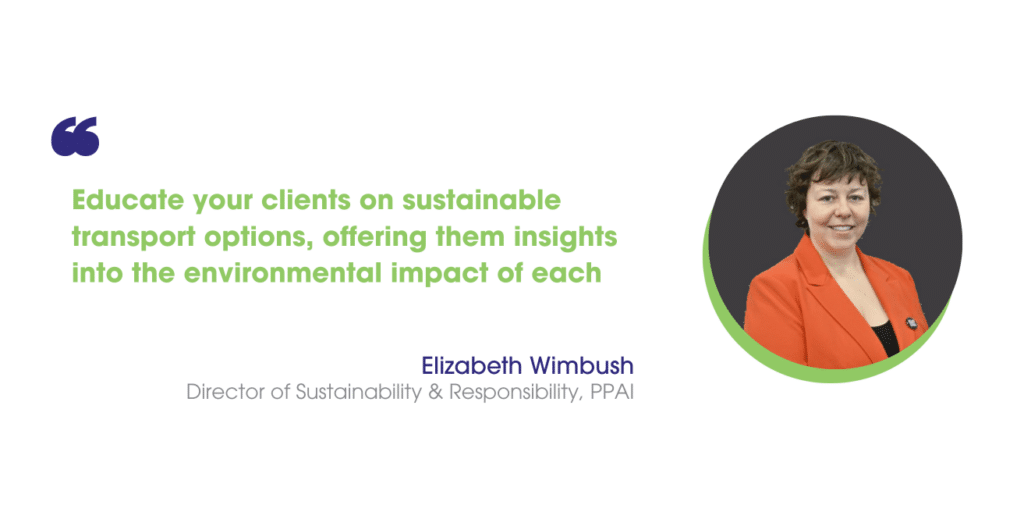In our dynamic industry, sustainability is becoming increasingly important.
While much attention is given to the environmental considerations of the products themselves, one significant contributor to our carbon footprint often flies under the radar: air freight. Yes, I did just use that pun. Thank you for noticing.
For anyone looking to drastically reduce their carbon footprint, a great place to start is grasping and actively mitigating the environmental consequences of air freight.
The Impact Of Air Freight
Air freight, with its unmatched speed and efficiency, is one of the most carbon-intensive modes of transportation.
- Consider this: air freight emits around 1.1 pounds of CO2 per ton-mile, whereas shipping by sea emits only about 0.022 to 0.088 pounds of CO2 per ton-mile.
- That’s 12 to 50 times more carbon intensive as soon as your branded merch gets on a plane.
Once product lands on North American shores, we have more opportunities for positive impact. When we look at domestic freight, the carbon emissions from air freight versus truck or rail transport can vary significantly. In fact, truck and rail transport tend to have lower carbon emissions per ton-mile for domestic shipments.
Riveted by this and want to learn more? Love your passion, and I’ve got you – check the U.S. Environmental Protection Agency (EPA), which provides valuable data on emissions factors for different modes of domestic freight transport.
Strategies For Promo Distributors
Distributors are in a unique position to influence the supply chain and promote more sustainable practices, especially if you’re in sales. Here are several meaningful steps that can be taken to reduce reliance on air freight and mitigate its environmental impact, both domestically and internationally.
First, educate your clients on sustainable transport options, offering them insights into the environmental impact of each. Infographics can be helpful to illustrate the benefits of choosing lower-emission options like truck or rail transport for domestic shipments and sea transport for international shipments.
- Highlight not only the reduced carbon footprint, but also the cost savings associated with these alternatives.
Second, promote locally sourced products and emphasize their benefits. This can be as simple as being conscious of choosing a decorator partner closest to the final delivery point and asking your blank garment supplier to ship from a nearby warehouse. It might seem obvious, but don’t assume this is the default. By reducing the distance traveled from production to distribution, you can minimize the need for long-haul transportation.
- Bonus points for highlighting local partnerships, as the positive impact on communities can resonate with purpose-driven clients.
Third, collaborate with suppliers and logistics partners to optimize supply chain efficiency. Ask questions about what your options are. By reducing unnecessary packaging and consolidating shipments, you can minimize the need for expedited shipping methods like air freight. Encourage clients to plan ahead and place orders in advance to avoid rush shipments. (I know, you’ve never heard this one before…but it’s worth repeating for the impact potential it has.)

Lastly, explore opportunities to invest in sustainable logistics practices, such as using hybrid or electric trucks for local deliveries or supporting rail transport for long-distance domestic shipments. If that’s not something you have any say in, do some research and work with transport companies that prioritize reducing their carbon footprint. Partnering with carriers that focus on reducing their environmental impact can enhance your brand’s reputation and attract environmentally conscious clients.
We All Play A Part
Regardless of your job title or company type, each of us holds the power to inspire positive change. Our actions have the power to shape the trajectory of sustainability in our sector.
Educating ourselves and advocating for lower impact transport options, alongside collaborating with environmentally responsible partners, allows us to play a crucial role in advancing sustainability across the promotional products supply chain. Every effort, no matter how seemingly small, contributes to the larger goal of reducing carbon emissions and mitigating environmental impact.
- The industry’s shift towards sustainable practices, including the adoption of lower-impact transport options, ensures our long-term relevance and competitiveness in a changing market landscape.
Let’s unite in steering promo towards a future where sustainability isn’t just an aspiration, but a guiding principle in every aspect of our operations. Together, through innovative solutions and collaborative efforts, we can forge an environmentally conscious supply chain that drives business growth and significantly reduces our carbon footprint, safeguarding the health of our planet for generations to come.
I sincerely hope you heard John Williams-style hero music playing in your head while reading that.
Wimbush is the director of sustainability and responsibility at PPAI.


